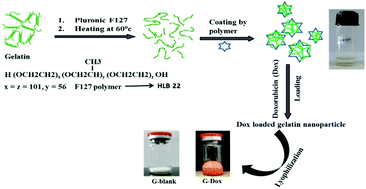Preparation of a size selective nanocomposite through temperature assisted co-assembly of gelatin and pluronic F127 for passive targeting of doxorubicin†
Abstract
The preparation of a water dispersible and pH responsive gelatin–F127 nanocomposite using a thermal relaxation approach is reported. The results indicated that physical properties (size and surface charge) of the gelatin–F127 nanoparticle can be tuned by varying the F127 to gelatin weight ratio. The heating (60 °C) of a saline solution (pH 7.4) containing 0.5% (w/v) of gelatin and 20% (w/w of gelatin) of F127 followed by gradual cooling at room temperature yielded nanoparticles of desired size (160 ± 40 nm), viscosity (1.36 ± cP) and surface charge (−6.47 ± 0.7 mV). The drug delivery application of nanocarriers was investigated using doxorubicin hydrochloride (Dox) as a model drug. These nanocarriers showed high encapsulation efficiency of Dox (85%), a sustained release profile, and substantial cellular internalization. Additionally, Dox loaded nanocarriers (G-Dox) exhibited prolonged residence in blood as evidenced by their longer circulation time as compared to plain Dox. Moreover, G-Dox exhibited a higher availability of the drug in plasma as compared to nonspecific organs such as the heart, liver and kidneys, highlighting its significance in reducing drug associated side effects. Finally, the enhanced toxicity of G-Dox to a WEHI-164 (fibrosarcoma) tumor model as compared to that of plain Dox under an identical dosage of 6 mg per kg body weight (IP) confirmed its potential for chemotherapy application.



 Please wait while we load your content...
Please wait while we load your content...